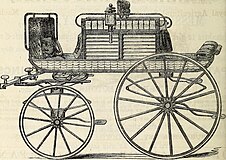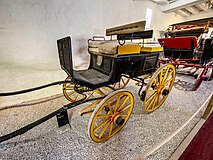
A cart or dray is a vehicle designed for transport, using two wheels and normally pulled by draught animals such as horses, donkeys, mules and oxen, or even smaller animals such as goats or large dogs.

A carriage is a private four-wheeled vehicle for people and is most commonly horse-drawn. Second-hand private carriages were common public transport, the equivalent of modern cars used as taxis. Carriage suspensions are by leather strapping or, on those made in recent centuries, steel springs. Two-wheeled carriages are informal and usually owner-driven.

A phaeton was a form of sporty open carriage popular in the late eighteenth and early nineteenth century. Drawn by one or two horses, a phaeton typically featured a minimal very lightly sprung body atop four extravagantly large wheels. With open seating, it was both fast and dangerous, giving rise to its name, drawn from the mythical Phaëthon, son of Helios, who nearly set the Earth on fire while attempting to drive the chariot of the Sun.
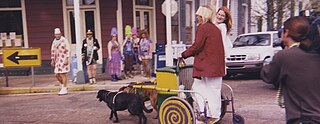
Carting is a dog sport or activity in which a dog pulls a dogcart filled with supplies, such as farm goods, camping equipment, groceries or firewood, but sometimes pulling people. Carting as a sport is also known as dryland mushing and is practiced all around the world, often to keep winter sled dogs in competition form during the off-season.

A sulky is a lightweight cart used for harness racing. It has two wheels and a small seat for only a single driver. The modern racing sulky has shafts that extend in a continuous bow behind the driver's seat, with wire-spoked "bike" wheels and inflated tyres. A sulky is frequently called a "bike". Historically, sulkies were built for trotting matches and made from wood with very tall wheels and almost no body, just a simple frame supporting a single seat. Such vehicles were called "sulkies" because they were "said to have been chosen by unsociable people fond of their own company or fits of sulking".

A gig, also called chair or chaise, is a light, two-wheeled sprung cart pulled by one horse.

A buckboard is a four-wheeled wagon of simple construction meant to be drawn by a horse or other large animal. A distinctly American utility vehicle, the buckboard has no springs between the body and the axles. The suspension is provided by the flexible floorboards of the body and a leaf spring under the seat(s). The buckboard has no sideboards on the body, leaving the floor quite mobile. In rough terrain, the floor can flex and "buck", lending the vehicle its name.

A horse-drawn vehicle is a piece of equipment pulled by one or more horses. These vehicles typically have two or four wheels and were used to carry passengers or a load. They were once common worldwide, but they have mostly been replaced by automobiles and other forms of self-propelled transport but are still in use today.

A sprung cart was a light, one-horse, two-wheeled vehicle with road springs, for the carriage of passengers on informal occasions. Its name varied according to the body mounted on it.

A lorry or lorrie was a low flat horse-drawn vehicle with no sides, related to the trolley and dray.

A tonga or tanga is a two-wheeled carriage drawn by a single horse. It is used for transportation in the Indian subcontinent. There is a canopy over the body, one seat faces forward for the driver and one passenger, and one seat faces the rear for a second passenger. Some space is available for baggage below the carriage, between the wheels. This space is often used to carry hay for the horses.
The following outline is provided as an overview of and topical guide to transport:
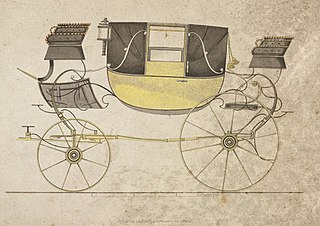
In coachbuilding, a landau is a four-wheeled carriage with a roof that can be let down. It was a luxury carriage. The low shell of the landau provides maximal visibility of the occupants and their clothing, a feature that makes a landau still a popular choice for Lord Mayors in the United Kingdom on ceremonial occasions.

Driving, when applied to horses, ponies, mules, or donkeys, is a broad term for hitching equines to a wagon, carriage, cart, sleigh, or other horse-drawn vehicle by means of a harness and working them in this way. It encompasses a wide range of activities from pleasure driving, to harness racing, to farm work, horse shows, and even international combined driving.

A droshky or drosky is a term used for a four-wheeled open carriage used especially in Russia. The vehicle has a long bench on which the driver or passengers sit as if on a saddle, either astride or sideways. From droga, the pole that connects the front and rear axles.
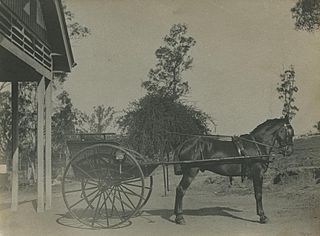
A trap, pony trap or horse trap is a light, often sporty, two-wheeled or sometimes four-wheeled horse- or pony-drawn carriage, usually accommodating two to four persons in various seating arrangements, such as face-to-face or back-to-back. In the eighteenth century, the first carriage to be called a trap was a gig with a hinged trap door, under which was a place to carry a dog. In late nineteenth century USA, four-wheeled dog carts with convertible seats also started to become known as traps.

A vis-à-vis is a carriage in which the passengers sit face to face with the front passengers facing rearward and the rear passengers facing forward. The term comes from the French vis-à-vis, meaning face to face.
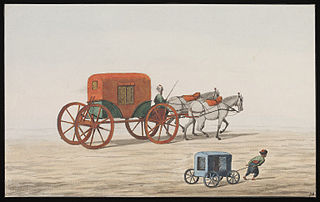
An araba is a carriage drawn by horses or oxen, used in Turkey and neighboring countries in the 18th and 19th centuries, with crosswise seating and usually with a canopy top to protect occupants from the sun and afford privacy. It is usually heavy and built without springs; when it has springs it is called yaylı, shorter form of "yaylı araba" or "araba with springs".

A Ralli car is a traditional type of horse-drawn cart, named after the Ralli family. The vehicle was commonly used as a general run-around for families.

A governess cart is a small two-wheeled horse-drawn cart. Their distinguishing feature is a small tub body, with two opposed inward-facing seats. They could seat four, although there was little room for four large adults. The driver sat sideways on one of these seats. The centre rear of the body was lowered, or else had a small hinged door, and there was a step beneath. The wheels were of moderate size, always fitted with mudguards, and usually carried on elliptical springs. The axle was either straight or dropped, giving a low, stable, centre of gravity.



